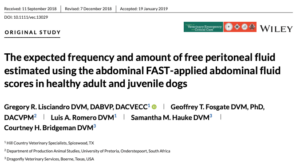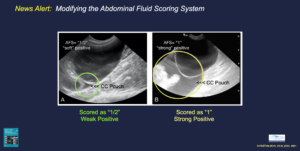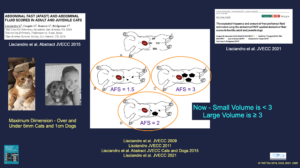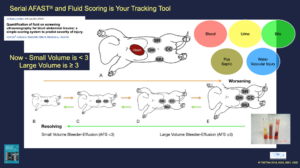Our AFAST®-applied Fluid Scoring System’s “Small Volume and Large Volume Bleeder/Effusion Principle” has been updated!

The *AFAST®-applied Fluid Scoring System has been modified based on some more recent clinical research published as abstracts in adult and juvenile cats and dogs, and then as a formal manuscript in dogs (Lisciandro et al. JVECC 2021). This is an important change for assessing both hemorrhagic and non-hemorrhagic effusions in dogs and cats but also may be applied to other species. The AFAST®-applied Fluid Scoring System now has a “weak positive” and “strong positive” model with “weak positives” scored as “1/2” and “strong positives” scored as a “1.”
*Note that the AFAST®-applied Fluid Scoring System is ONLY validated in LATERAL recumbency. We follow the “FASTVet 3-minute Rule” when free fluid is detected in standing/sternal patients. The “FASTVet 3-minute Rule” is when a patient is “positive” in standing or sternal, they must be moved, when safe to do so, to either lateral recumbency, wait 3-minutes to allow fluid to re-distribute, and then perform the AFAST®-applied Fluid Scoring System.
There are 2 ways that we illustrate this AFAST® modification and update – 1) the “Visual Method” and 2) the “Absolute Measurements of Maximum Dimension Method” to differentiate a “weak positive” from a “strong positive.” The author’s “Visual System” is there a “small triangle” of fluid, “weak positive”, or a “large triangle” of fluid, “strong positive” as illustrated in the figure below. For the “Absolute Measurements of Maximum Dimension Method” we can take the maximum dimension and “over or under of 0.5 cm” in cats, and “over or under 1 cm” in dogs, defines “weak positive (1/2)” from a “strong positive (1).”
With this updated AFAST®-applied Fluid Scoring System, now “small volume bleed/effusion” is defined as less than three (<3) and “large volume bleed/effusion” is defined as greater than or equal to three (≥3).
Figure. The Author’s “Visual System” for “Weak Positive” versus “Strong Positive.”
Figure. The Modification Better Categorizes “Small Volume (1/2)” versus “Large Volume (1)” Bleeder-Effusion. Note that in C) there is a true large volume of “3” compared to B) with our new system that is a small volume of “1.5” that would not be differentiated using our original system (Lisciandro et al. JVECC 2009).
Figure. The AFAST®-applied Fluid Scoring System for Tracking Patients – worsening (increasing abdominal fluid score, AFS) is moving to the right, or improving/resolving (decreasing abdominal fluid score, AFS) is moving to the left, or static (no change in AFS). Veterinarians have a huge advantage over our physician counterparts because of the lack of a simple FAST fluid scoring system in people.
FASTVet 48-hour Bleeding Rule. EXPECT dogs and cats (and likely other species) to resorb the blood in their abdominal cavity within 48-hours if bleeding has ceased and coagulopathy, when present, has been corrected (unpublished, author experience). No studies to the author’s knowledge have published this information but it serves as a good “FASTVet AFAST® Rule of Thumb.”
See our FASTVet Chart for the Bleeding Patient and Characterizing Effusions!
gl/GL 4-3-2023






